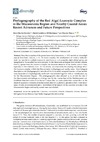Identificador persistente para citar o vincular este elemento:
https://accedacris.ulpgc.es/jspui/handle/10553/49770
| Campo DC | Valor | idioma |
|---|---|---|
| dc.contributor.author | Machín-Sánchez, María | - |
| dc.contributor.author | Gil-Rodríguez, Maria Candelaria | - |
| dc.contributor.author | Haroun, Ricardo | - |
| dc.date.accessioned | 2018-11-24T10:34:01Z | - |
| dc.date.available | 2018-11-24T10:34:01Z | - |
| dc.date.issued | 2018 | - |
| dc.identifier.issn | 1424-2818 | - |
| dc.identifier.other | WoS | - |
| dc.identifier.uri | https://accedacris.ulpgc.es/handle/10553/49770 | - |
| dc.description.abstract | Since the conception of the genus Laurencia by Lamouroux in 1813, several red macroalgal species have been included in it. In recent decades, the development of modern molecular tools has resulted in multiple taxonomic modifications, and presently, eight related genera are recognized in the so-called Laurencia complex. In the Macaronesian Region (Central East Atlantic Ocean), species from the Laurencia complex are keystone elements of the benthic communities, especially in the intertidal zone. In this review, we consolidate the existing knowledge about the Laurencia complex within the Macaronesian archipelagos and nearby areas. Morphological descriptions and phylogeographic remarks of the 16 currently accepted species—whose records were molecular or morphologically confirmed—are included together with an identification key for the Macaronesian Region. The phylogeographic data allowed us to re-visit the role of the Macaronesian archipelagos as a bridge area for the marine flora of the Mediterranean and Caribbean Seas (remnants of the former Thetyan Sea) or contemplate their marine flora as the result of successive processes of recolonization after the Quaternary glaciations from those donor areas. Finally, some comments about the frontiers of the research in the Laurencia complex in the Macaronesian Region and nearby coastal areas are included. | - |
| dc.language | eng | - |
| dc.relation.ispartof | Diversity | - |
| dc.source | Diversity [ISSN 1424-2818], v. 10 (1), p. 10-21 | - |
| dc.subject | 2417 Biología vegetal (botánica) | - |
| dc.subject | 250501-1 Biogeografía botánica | - |
| dc.subject.other | Molecular systematic | - |
| dc.subject.other | Laurencia | - |
| dc.subject.other | Laurenciella | - |
| dc.subject.other | Palisada | - |
| dc.subject.other | Osmundea | - |
| dc.subject.other | Azores | - |
| dc.subject.other | Madeira | - |
| dc.subject.other | Selvagens | - |
| dc.subject.other | Canary Islands | - |
| dc.subject.other | Cape Verde | - |
| dc.subject.other | Biogeographic relationships | - |
| dc.title | Phylogeography of the red algal Laurencia Complex in the Macaronesia region and nearby coastal areas: Recent advances and future perspectives | - |
| dc.type | info:eu-repo/semantics/Article | - |
| dc.type | Article | - |
| dc.identifier.doi | 10.3390/d10010010 | - |
| dc.identifier.scopus | 85042209259 | - |
| dc.identifier.isi | 000428553300009 | - |
| dc.contributor.authorscopusid | 55249969300 | - |
| dc.contributor.authorscopusid | 55931556200 | - |
| dc.contributor.authorscopusid | 6603827643 | - |
| dc.identifier.eissn | 1424-2818 | - |
| dc.identifier.issue | 10 | - |
| dc.relation.volume | 10 | - |
| dc.investigacion | Ciencias | - |
| dc.type2 | Artículo | - |
| dc.contributor.daisngid | 4435550 | - |
| dc.contributor.daisngid | 1297441 | - |
| dc.contributor.daisngid | 29952750 | - |
| dc.description.numberofpages | 21 | - |
| dc.utils.revision | Sí | - |
| dc.contributor.wosstandard | WOS:Machin-Sanchez, M | - |
| dc.contributor.wosstandard | WOS:Gil-Rodriguez, MC | - |
| dc.contributor.wosstandard | WOS:Haroun, R | - |
| dc.date.coverdate | Marzo 2018 | - |
| dc.identifier.ulpgc | Sí | es |
| dc.description.sjr | 0,603 | |
| dc.description.sjrq | Q1 | |
| dc.description.scie | SCIE | |
| item.fulltext | Con texto completo | - |
| item.grantfulltext | open | - |
| crisitem.author.dept | GIR ECOAQUA: Biodiversidad y Conservación | - |
| crisitem.author.dept | IU de Investigación en Acuicultura Sostenible y Ecosistemas Marinos (IU-Ecoaqua) | - |
| crisitem.author.dept | Departamento de Biología | - |
| crisitem.author.orcid | 0000-0003-1348-692X | - |
| crisitem.author.parentorg | IU de Investigación en Acuicultura Sostenible y Ecosistemas Marinos (IU-Ecoaqua) | - |
| crisitem.author.fullName | Haroun Tabraue, Ricardo Jesús | - |
| Colección: | Artículos | |
Citas SCOPUSTM
10
actualizado el 08-jun-2025
Citas de WEB OF SCIENCETM
Citations
10
actualizado el 12-ene-2026
Visitas
328
actualizado el 16-ene-2026
Descargas
188
actualizado el 16-ene-2026
Google ScholarTM
Verifica
Altmetric
Comparte
Exporta metadatos
Los elementos en ULPGC accedaCRIS están protegidos por derechos de autor con todos los derechos reservados, a menos que se indique lo contrario.
